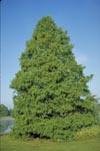Home >
Taxodium distichum, Baldcypress
Baldcypress is ideal for wet locations, such as its native habitat of stream banks and mucky soils, but the trees will also grow remarkably well on almost any soil, including heavy, compacted, or poorly-drained muck, except alkaline soils with a pH above 7.5. Some trees may tolerate zone 4 conditions.
Trees occur throughout the entire state of Florida.
Baldcypress is relatively maintenance-free, requiring pruning only to remove dead branches and unwanted lower branches which persist on the tree. It maintains a desirable straight trunk and a moderately dense canopy and does not form double or multiple leaders as do many other large trees. Not unlike some of the pines, the canopy on trees in native habitat slowly develops a more open, spreading habit as it ages with large diameter branches spaced along the top have of the trunk. Trees can be pruned to maintain a specified height and spread (see photographs). Trees tend to have a low failure rate meaning that branches break from these trees less often than from some other trees.
Pondcypress is found in stagnant pools of water whereas Baldcypress tends to be more common along stream banks. Both grow in water or on more well-drained soils. They tolerate drought better than could be expected for a tree so common to wet soils. In fact, trees grow faster in a well-drained, moist soil than they do in a wet site. It appears as though in nature they simply out-compete other trees in wet soil rather than prefer wet soil. Although tolerant of drought, some trees in the woods and some planted trees died back in the southeastern US as a result of the 1998-2000 LaNina weather event that caused severe drought. This was an exceptional weather event. The large buttress trunk is thought to develop in response to the instability of the root system inherent to trees growing in soft submerged soil.
They are well adapted to planting in downtown areas where there is little exposed soil. It has been successfully used as a street tree in some communities and is being use more for this purpose. Trees are spaced apart 18 to 20 feet in some of the nicest street tree plantings. They are also useful on roadsides in ditches and other wet areas. They make a wonderful vertical statement in the landscape and can be used as Lombardy poplar was used in cooler climates before disease ravaged Lombardy poplar, or Italian Cypress in the warmer climates. Roots are able to grow beneath sidewalks and pavement with little trouble.
Trees planted in wet sites develop above-ground root extensions called `knees', referred to as pneumatophores by scientists, that can make mowing operations difficult near the tree. 'Knees' are thought to aid in gathering oxygen. These `knees' usually do not form in well-drained soils, although I (Dr. Gilman) have seen cases where they have developed. Despite their tolerance to flooded soil, trees establish very slowly when planted in water, but they do establish. Chlorosis can develop on soils that are highly alkaline.
Wood
weighs about 46 pounds per cubic foot.






